NEW TOP TEN GAMES
AT THE AOE '83
BY STEVE ARRANTS
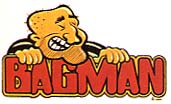
|
(STERN)
Even though it had already received distribution months before the show, no other game at the Stern booth drew more attention than Bagman. Licensed from a French corporation, Bagman is a lighthearted cops and robber chase game which takes place in a series of underground mine shafts.
As an escaped criminal, you maneuver through tunnels trying to retrieve money bags which you must place in the wheelbarrow at the surface. By use of a four-way joystick, you move horizontally and vertically. The single action button is used to perform various tasks at different stages of the game. A group of armed guards chases you about the mine shafts, but they are stunned temporarily when you hit them with a pickaxe or moneybag.
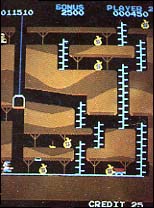
|
The extensive mine complex stretches along three complete screens. You begin each game in the leftmost section, but by exiting the screen through the horizontal tunnels at the right, you shift scenes to the middle portion of the mine. Your movement between the different sections is unrestricted, but you must always return the money bags to the wheelbarrow. Luckily, you can move the wheelbarrow to anywhere you wish along the surface.
Bagman doesn't break any graphics or technical barriers, it is simply a creative game that is fun to play. The characters are portrayed in cartoon-like proportions and the cute sound effects add to the appeal of the game. Bagman borrows many ideas from the slew of climbing games that followed Donkey Kong, and incorporates them into a novel package.

(SEGA)
With success stories such as Zaxxon and Frogger in its past, operators were counting on Sega to introduce a new game to capture the imagination, and quarters, of the game-playing public. Congo Bongo proved to be just what the doctor (Livingston) ordered.
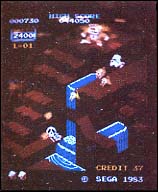
|
You are the great Hunter, trying to capture Bongo the gorilla. Movement is accomplished with an eight-position-joystick and a jump button. All movement must be calculated very carefully, since it is easy to jump over a cliff or into a watery grave. The object is to maneuver your safari explorer to predesignated places on the playfield. These spots are identified by the small white arrows, and are always near Bongo the gorilla. As in Donkey Kong, there are four different screens, and each screen presents its own unique challenge.
On the first board, you climb and jump up the steep cliffs of Primate Peak while dodging the bouncing coconuts that Bongo is throwing at you. A playful group of monkeys that roam this board can severely hamper your success if you allow them to climb onto your back. Three jumps knocks them off of your back, but be quick. If all three monkeys jump on your back at one time, prepare yourself for a humorous demise.
After reaching the summit of the cliff, Bongo retreats to Snake Lake. Conquering the dangers of the lake only brings your adventurer closer to Bongo's resting place on the fourth screen. If you are skilled enough to surprise the gorilla as he snoozes, you advance to the next level of the game and begin again on a more advanced first board.
Congo Bongo utilizes the 3D-like graphics system popularized by Zaxxon and Super Zaxxon. The game screen scrolls only after the completion of a board, but the three-quarters viewpoint is an interesting way to display the graphics of this game. Unlike Zaxxon, Congo Bongo is full of vibrant colors and has distinct contrast between the game elements. The zany animation of the animals, combined with jungle sound effects, create the complete safari motif that is sure to entice both Donkey Kong players, as well as those who enjoy Jungle Hunt.
(CINEMATRONICS)
Although they filed for Chapter XI bankruptcy back in November of 1982, Cinematronics was at the show in full strength. Ironically, Dragon's Lair, the most innovative game at the AOE, comes from this financially troubled company. The folks at Cinematronics are promoting Dragon's Lair as a game that is "light years ahead of its time." Utilizing the sophisticated technology of laser disc animation, Dragon's Lair is a major step forward for the industry.
Dragon's Lair is the first laser disc video game to be implemented in the coin-op arcade halls. The cartoon graphics and storyline were designed by Starcom, but the machine is manufactured and marketed by Cinematronics.
Using only a two-direction joystick and an action button, you control the hero, Dirk the Daring. Your quest: rescue the princess who is held somewhere in the dark castle. Essentially, this game is one long cartoon with options controlled by the player. Should Dirk battle the Black Widow Spider or run away? Is it safe to pull the gold chain hanging from the ceiling? Which corridor leads to the princess--and which leads to a nasty death?

|
At the beginning of every game, you automatically enter the first room and the door slams shut behind you. Suddenly you are on a small ledge above a pit of fire. You must swing from rope to rope to cross over the flames as they lick at your feet. Each time that you use a control or the scene changes, the screen goes blank for a second as the computer repositions the scanner on the video disc. Until the technology of the disc field advances, players must contend with these hiatuses in the gameplay.
The cartoon graphics are well animated. So well that many viewers speculated that the artwork was done by the masters of animation, Walt Disney Productions. Representatives of Cinematronics and Starcom would neither confirm or deny this conjecture. Since the demonstration models that were on display at the show did not contain the complete game, there is no way to determine how complex and involved the game will actually be when it finally reaches your arcade. Due to the simplicity of the controls, there is not too much room for options and diversity of actions. Once you have mastered the timing of the controls, you can virtually walk right through the demo game. We can only hope that Cinematronics releases a greatly expanded version of Dragon's Lair to the public. The company also plans to continue support for the laser disc system by periodically introducing new interchangeable packages to be used with the master console.
The drawing power of Dragon's Lair lies mainly in the fact that it is the first laser disc video game. The format and execution of this game is such a radical departure from the usual that it may not be readily accepted by the arcade owners and operators. I am sure, however, that the novelty appeal of the game is more than enough to make it successful with the players. With its dank caverns, exciting encounters and awesome foes, Dragon's Lair should be very popular with the Dungeons and Dragons sub-culture.
(ATARI)
Atari, both the father and giant of the industry, had the most impressive booth at the AOE. It was the size and grandeur of the booth that made it impressive, not necessarily the games displayed within. Luckily the newest release, Food Fight, was not overshadowed by the lavish booth.
The object of Food Fight is to race Charley Chuck across the screen to a melting ice cream cone. Easy? No way! Our hero must dodge tomatoes, pies, and watermelons that are thrown at him by a band of four outraged chefs. If you do not avoid the flying objects, you become covered with food and lose a life.
Your only defense is a rugged offense. By throwing food at the chefs faster than they can fling it at you, your opponents can be temporarily eliminated. If you pass over a pile of foodstuffs, you arm yourself with that type of ammunition. Now when threatened by a chef, you can lob food at him by pointing the joystick in his direction and tapping the throw button. If you hit a chef, he melts away, but later reappears.

|
The chefs enter the screen through little slots in the playfield floor. If a character passes over an open hole, he falls to his death. As you weave your way to the elusive ice cream cone, you must carefully avoid the open slots and the flying food. Since chefs can be coaxed into hitting each other and failing into holes, Food Fight can be played as a strategic game as well as a hand-eye exercise.
To accommodate the more sophisticated players, Food Fight allows you to select the level that you wish to start the game on. This is similar to how you begin a game of Tempest. The higher the level you choose, the more difficult the game and the greater number of lives you begin with.
One of the nicest things about Food Fight are the stunning graphics. Dressed in a blue shirt and white pants, Charley Chuck grabs pieces of food that are depicted in great detail and throws them at the grinning chefs. There is a large variety of different foods, each with its own characteristics. For example: watermelon supplies can never be exhausted. The way that the bananas spin through the air is especially cute--they look just like little yellow boomerangs. Another interesting feature of Food Fight is the Instant Replay. If you have a close shave and almost get hit by some food, your actions for that entire level will replay for you in fast motion. This is a novel idea and also gives the player a chance to see what he did right.
Atari will probably do very well with Food Fight. The brilliant colors, whimsical music and distinctive cabinet design certainly attract the player's attention to this game. The humorous yet challenging gameplay is sure to keep that attention.

(CENTURI)
The most memorable game ever manufactured by Centuri is unquestionably Phoenix. While it is difficult to produce a new game to surpass a very successful old one, Centuri is definitely trying hard. While I don't think that Gyruss will ever reach the popularity level enjoyed by Phoenix, it certainly won't trail too far behind.
Starting on the periphery of our Solar System, you must fight your way back to Earth. Your ship is restricted to an orbital path that is almost tangent to the four edges of the screen. A two-directional joystick moves your ship, the Gyruss, clockwise and counterclockwise along an orbital path. You can blast away at the alien ships by tapping the fire button on the right of the control panel.
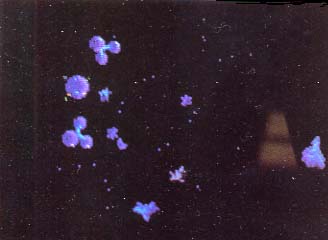
|
To reach earth, you must trek through space by destroying waves of aliens. The invaders materialize in the vortex at the center of the screen. When a group of aliens has amassed, they rush the player by zooming up toward the rim and hurling multi-shaped bombs. After this aggressive action, they retreat to the center of the screen where they wait as additional waves of aliens attack. In addition to the indestructible bombs, huge meteoroids come screaming out of the vortex to keep you on your toes.
Every time that you eliminate a complete attack wave of creatures, it counts as one warp toward your planet of destination. The first planet, Neptune, is only two warps away. Each successive planet requires more warps to reach than the one preceding it. After every four stages, you enter a chance stage in which you are invulnerable to the aliens. Two strings of five creatures each enter the screen and tempt you to shoot them all. The object of these chance stages is to pick up bonus points by destroying the aliens as they pirouette, twist and wriggle through space. Your main mission is to succeed in finally reaching Earth.
Gyruss is a fast-paced game that has a subtle hint of Tempest in its design. The interesting sound effects and dazzling dances of the enemy ships is enough to mesmerize you if you're not careful. Although it is not another Phoenix, Gyruss is sure to be one of the most popular space-games of the coming year.

(BALLY/MIDWAY)
Well, after all of the speculation as to which home video game was going to be the first to be adapted for the coin-op arcade, Journey, from Bally/Midway, answers that question once and for all. The Atari VCS home game from Data Age, Journey Escape, was the inspiration for this coin-op.
Journey is the name of America's current #1 rock group whose exploits are supposedly depicted in the game. Released in conjunction with their U.S. Frontier tour, the object of the Journey arcade game is to help the five band members collect their instruments so that they can perform together at a concert.

|
The game Journey is based on the same principal as Tron. By designing the cabinet and game to tie-in visually with the band's newest LP release, Frontiers, Bally hopes to draw the fans of the rock group to the machine. While this is good business practice, it doesn't justify the exploitation of the band's popularity to produce a mediocre package of games. As is the case with Tron, Journey is composed of several different hackneyed game concepts.
The game begins with an overhead view of a scarab ship, the group's symbol, and five planets, each with a musical instrument located in its center. By using the joystick to guide the ship toward a planet, you choose which subgame you want to enter. To acquire an instrument, you must accomplish a specific task. For example, to help Steve Smith retrieve his drum set, you must first change the color of a group of floating discs by bouncing on them. After that, you climb aboard the drums and must blast through flocks of flying debris before you can regroup with the other band members. The other musicians all have different obstacles that they must overcome before they can perform at the concert to the delight of teeny-boppers everywhere.
While it is probably obvious at this point that I do not really enjoy playing Journey, you may be asking yourself why I have included it in my list of the top ten games.
The answer is simple: the popularity of the group is most likely strong enough to carry the game, and Tron has already proved that four O.K. games do a winner make. What this means is that Journey has a very good chance of becoming a favorite among arcade goers despite its shortcomings. Don't let me sell Journey short though, it does have some redeeming qualities, most notably, the superb graphics. All of the five game stages have vividly colored animation, but the best thing is that the faces of the band members look as if they are black and white photographs. This is one of the biggest steps toward making game graphics appear more true to life.
(NINTENDO)
Without a doubt, Mario Bros. was my favorite game at the AOE'83. Borrowing the jumpman character from Donkey Kong, the designers at Nintendo have placed Mario and his brother Luigi in a new game that is sure to climb the popularity charts.
In this game, Mario the Plumber must contend with pests along a waterfront. The first level starts out with Shellcreepers (turtles). They emerge from the mouths of the two green pipes at the top of the screen. The idea behind Mario Bros. is that you are supposed to clear the boards (called faces) that are infested with creeping, crawling pests. To do this, you must first knock them onto their backs and then kick them into the water below.
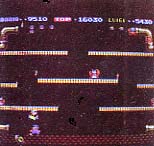
|
To flip a creature onto its back, you must position yourself on the platform beneath it. When the pest is directly above you, press the jump button to punch the ground that it is walking on. Unless the creature happens to be a second level sidestepper, this renders it temporarily defenseless. At this point you may jump up the platform that the pest is on and kick it into the water by touching it with your man. If left alone for a short period of time, the creature rights itself and becomes a much more ferocious adversary. When you kill a creature, a bonus coin is introduced into the playfield. This spinning coin makes its way down to the bottom of the screen and disappears forever if nobody touches it.
When played by two people at the same time, Mario Bros. takes on a whole new dimension. Similar to the cooperation relationship of the Joust video game, both players must formulate a code of ethics if they hope to do well. Working as a team, two good players can make a game of Mario Bros. a joy to behold. Then again, two bumbling players make for hilarious action on the screen.
One new concept introduced in Mario Bros. is the slippery floors. When you tilt your two-direction joystick in any one direction for more than a moment, you begin to gain momentum. To stop moving, you must reverse the direction of the joystick. Instead of coming to a complete halt, you grind your heels into the ground and slide for a little while. It is this uncertainty of movement that causes players to be a bit more careful.
The graphics of Mario Bros. are bright and colorful. The hi-res floors and waterpipes are shaded to give the illusion of three dimensions, and each character is animated with a great attention to detail. The three different creatures encountered in Mario Bros. are tricky enough to keep even the best of players on their toes.
When played by a single person, Mario Bros. is a good game. But when two players go head-to-head, it becomes an excellent game. I hope that Nintendo plans to release this game soon. I'm saving my quarters in anticipation. Mario Bros. is a strong contender for game of the year.
Gottlieb is a relative newcomer to the very competitive video game market. Its first game, Reactor, was quietly introduced at last year's show. In striking contrast, Mad Planets received more than its fair share of attention at the 1983 AOE. Coming on the heels of the immensely popular Q*Bert, Mad Planets is no disappointment.
As the pilot of a small ship, you have become lost in space and now find yourself in a sector where planets are born. The object of Mad Planets is to destroy approaching planets and rescue helpless astronauts that are marooned in space. Your highly maneuverable space fighter is controlled via a spinning knob that rotates the ship, and a joystick with a firing button to move about the screen and blast targets. These controls are extremely responsive which is perfect for the incredibly accelerated gameplay found in Mad Planets.

|
At the beginning of every wave, the embryonic platlets appear as small eggs in the center of the screen. You cannot destroy a planet until it starts to grow in size. Once a planet becomes a qualified target, it is deadly to the touch and continues to grow until it sprouts moons or you blow it away. If a planet is allowed to reach full size, it is indestructible until you vaporize all of its orbiting moons. As long as it still has at least one moon, a planet may hurl lethal clones of that moon at your ship. Destroying the moons disables the planet's force field. When you have shot away all of the moons, the planet turns glowing red in color and increases its velocity. Unless you quickly destroy it, the planet bounces wildly off the edges of the screen, creating a very dangerous situation for the player.
If only one planet entered the playfield at a time, there would be no challenge to this game, but that is not the case. In addition to having multiple planets onscreen, there are also fierce comets that spiral through space that you must avoid. You can collect bonus points by touching the floating astronauts, but all too often this diverts your attention and causes you to lose a life.
Aside from the ferocious pace of the game, the beautiful graphics are what I really love about Mad Planets. When a planet reaches maturity, you can see the different continents etched onto the surface as it revolves around the axis. The orbiting moons actually leave small shadows on the planet itself! Due to the black design of the cabinet and the dark interstellar playfield, it is easy to become totally involved in the space world portrayed on the screen.
Mad Planets is not the kind of game that you want to play when you are in the mood to relax. Its action is so furious that your knuckles turn white as you frantically squeeze the trigger on the joystick while trying to avoid contact with the objects in the playfield. I would rank Mad Planets right up there with other high-tension favorites such as Robotron and Tempest. Gottlieb's Mad Planets guarantees sweaty palms and total exhaustion. Like Stern's Bagman, this game borrows from a specific genre of video games and achieves success.

(TAITO)
Taito, the company that gave the arcade world Space Invaders, introduced Zoo Keeper at the AOE. Both of its latest releases, Front Line and Jungle Hunt, have proven popular, and operators looked to Taito to come up with another winner.
In this game, you assume the guise of a zoo keeper whose job it is to keep all of the animals in their cage. The hungry animals are not content to remain locked up, and they chew at the inside of the brick wall that surrounds them in an attempt to break out. Every time that you make a pass along the outer perimeter of the wall, you add bricks and repair the sections that have been bitten into.
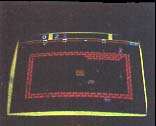
|
If you touch an animal, you lose a life. To avoid those creatures that escape the cage and crawl along the edge of the wall, you can press the jump button to leap over them. In other situations, you can use a net to return the animals to their cage. You can tell when the net and other prizes are going to appear by watching the fuse that burns down at the top of the screen. When the burning end of the fuse reaches a clover, watermelon, root beer or other goodie, that prize appears randomly on the perimeter of the cage. When the timer runs out, points are awarded for each animal that remains locked up in the cage. You then advance to the next screen.
Subsequent levels included cages that are non-existent at first and must be built from scratch, a screen with sliding platforms that you must climb to reach your girlfriend, and an escalator board in which you must avoid cages and animals. The action becomes quicker and more complex with each succeeding level. Survival becomes much more difficult. These four different types of screens present new and interesting challenges as you become a better player and attain enough skill to reach them.
The sound effects of the bricks being replaced as you race around the cage imitates the sound that a machine gun makes. This is in keeping with the quick pace that operators find desirable for shortened games and higher profits. But that is not to say that Zoo Keeper can't be played and enjoyed for longer sessions--it simply takes a little more time and effort to develop the necessary skills.

(WILLIAMS)
Williams introduced two video games at the AOE, Bubbles and a revised Sinistar, but its most impressive offering was the Joust pinball game. When thinking of arcade games today, most people typically envision a video game, not a pinball machine. Nevertheless, pinball was the most popular form of coin-op entertainment before video took over during recent years. With the introduction of this Joust pin game, pinball may be able to grab back some of the limelight.
The most impressive thing about the Joust pinball game is that the machine itself looks and plays like no other game before it. The glass above the playfield is horizontal, making it a convenient place to prop up a drink. This alone should attract the attention of the owners of bars and night clubs that feature game rooms. Joust is the first two-player pinball game in which both players are engaged in the competition simultaneously. The players approach the machine at opposite ends, and face each other for head-to-head action. This means that it can gobble down quarters twice as fast as any other pinball machine.
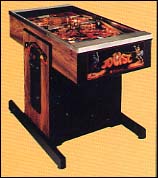
|
The Joust playfield is unique. The table is divided into two symmetrically identical fields which have different grades that slope down to the flipper set of each player. There are two separate openings from which the players are automatically fed new balls. When the game begins, the machine introduces two balls onto the playfield; one to each player. The object of the game is to rack up points by knocking down targets, hitting discs and rotating spinners with your ball. The novelty is that your table is connected to your opponent's table via two spinners and two special tunnels. If you are not careful, you may end up shooting your ball over to the other side-forcing your opponent to handle two balls at the same time! If he drains your ball, it is deducted from his reserve, not yours. You are only penalized for balls that you allow to sneak past your own flippers.
As far as mechanical innovations are concerned, Joust has none. The playfield is populated with thumper bumpers, drop targets, catch holes, spinners, rollover switches, bull's eyes and two sets of flippers--all fairly standard equipment in most pinball games today. The thing that sets Joust apart from any other pinball game is the simultaneous two-player action. When two friends engage in a game of Joust, they are not only battling the machine itself, but also each other.
As if the two-player option wasn't enough, William's has also incorporated some other nice features to make Joust ever more exciting. If one person plays Joust, he controls both sets of flippers with his one pair of buttons on his side of the cabinet. Not only must he judge where the desirable targets are on the other side (he can't see them from where he stands), he must also keep an eye on the playfield directly in front of him. This taxes the powers of observation and attention almost to the point of being absurd.
Probably the most exciting part of Joust comes after both players have drained their supply of balls. What follows is a thirty second free for all with four balls constantly in play. At this point the balls fly around so quickly that any attempt at strategic play is useless. The object is to juggle the balls to the best of your advantage to gain as many bonus points as possible. If you let a ball slip by your flippers, it is immediately thrown right back into the thick of things. The unlimited ball play is the most thrilling thirty seconds in pinball history.
Baby Pac-Man proved to the coin-op industry that variations on the standard pinball theme can be profitable. Joust is going to show the public just how successful and popular a pinball game can be in this age of computer monitors and joysticks. Without a doubt, Joust pinball is definitely going to claim a large portion of my paycheck when it makes its appearance in the local arcade. If pinball is to remain a viable source of arcade income, it owes its future to the continued introduction of original games such as Joust. Thank you, Williams! Pinball players are in your debt.